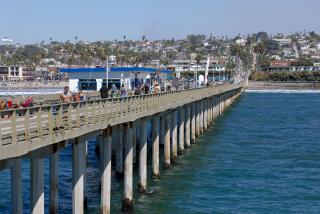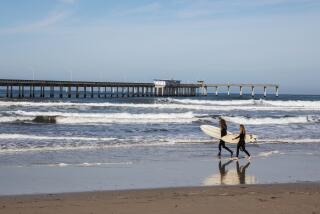Erosion Endangers Historic Lighthouse
- Share via
CAPE HATTERAS, N.C. — The Cape Hatteras Lighthouse has weathered decades of storms on its perch by the Atlantic, but scientists have argued recently that unless something is done soon, it might finally lose its fight with the sea.
The 126-year-old, spiral-striped building is the nation’s oldest lighthouse, a beacon known to millions of mariners, homeowners and vacationers who visit North Carolina’s Outer Banks.
But along with the beauty of the Southeastern coast are the perils of hurricanes and other fierce weather that pound the seaside, sending homes and other structures near the lighthouse crumbling into the surf.
Scientists said the ocean has been eroding the land on the south side of the 208-foot-tall lighthouse, and requested a new sea wall to help arrest the advance of the ocean near the tower. But the North Carolina Division of Coastal Management countered that the proposed 800-foot-long steel structure would violate strict state regulations.
“We really don’t allow that type of structure in the state,” said Alison Davis of the Coastal Management agency of the plan to construct a new “groin,” a low sea wall built at a right angle to the coast to reduce shore erosion.
“We are in full support of the state’s position on hardened structures,” responded Mary Collier of the National Park Service. “But what we’re requesting is a temporary structure.”
The Coastal Resources Commission was due to review the request for a fourth groin in November.
Aside from adding a groin to buttress the lighthouse, a proposal to move the tower altogether has gained support. But that plan also has problems, notably fear that advancing surf may come far enough inland to wipe out the relocation route that would move the lighthouse 2,500 feet to a safe spot away from the rough ocean waves.
Meanwhile, in an attempt to buy time for the lighthouse--toured by more than 150,000 people a year--Park Service engineers placed tons of sandbags around the base of the beacon. But they said something permanent was needed to protect the tower from a severe hurricane or succession of strong storms that may eventually topple it or weaken it to the point where it would have to be destroyed.
This year alone, the state was hit by Hurricane Bertha in July and Fran in September.
But the long-term solution for saving the lighthouse would be to lift the 3,000-ton structure--its black and white spiral bands serving to help navigate the treacherous Diamond Shoals during daylight--by rail and inch it to a new home, which industrial engineers said could be completed without damage to the tower or its base.
But the $12-million cost to do so was well beyond budget for the U.S. Department of the Interior, meaning saving the lighthouse would take an act of Congress.
“Obviously the funding would need to come after you decide what is the best solution,” said Rep. Walter B. Jones (R-N.C.). “The commitment is there.”
Other North Carolina politicians were trying to answer the call to save the lighthouse, too. State Senate President Pro Tem Marc Basnight said he planned to meet the state’s U.S. senators and Gov. James Hunt to review proposals to protect the light.
More to Read
Sign up for Essential California
The most important California stories and recommendations in your inbox every morning.
You may occasionally receive promotional content from the Los Angeles Times.










